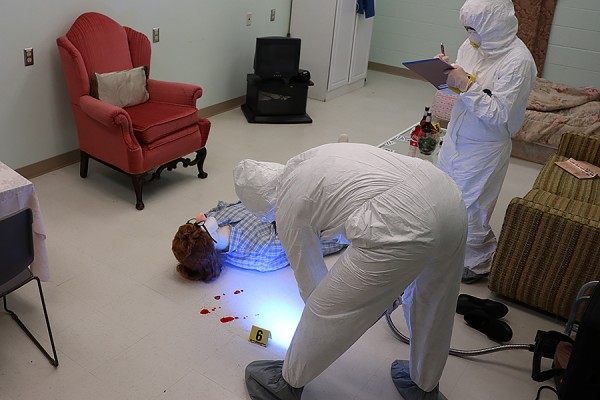 Forensic sciences students Stephanie Ringrose and Regan Pardo demonstrate investigative techniques in the mock crime scene condo.
Forensic sciences students Stephanie Ringrose and Regan Pardo demonstrate investigative techniques in the mock crime scene condo.
Inside what looks to be a nondescript Essex Hall office lies the new forensic sciences’ Mock Crime Scene Condo, staged with furniture, fake blood, and dummies as corpses. The crime scene demonstration room officially opened on October 19, along with the high-tech Forensic Innovation Research Lab.
“The Mock Crime Scene Condo will be used to demonstrate different crime scene investigative techniques to the Forensic Sciences students,” says forensic sciences professor Pardeep Jasra. “It will also be used to organize the CSI-Windsor workshops for high school students and to create public awareness regarding minimizing contamination of forensic evidence at a crime scene.”
After provost Douglas Kneale and earth and environmental sciences professor Maria Cioppa cut the crime scene tape ribbon, Dr. Jasra led staff, faculty, and students on a tour of the new facilities.
Forensic sciences students Stephanie Ringrose and Regan Pardo demonstrated technological tools, including CSI techniques such as fingerprints collection and fingerprints analysis using computerized pattern searching tool CSI-Pix Matcher, as well as blood stains identification, trace evidence and document identification.
The Forensic Innovation Research Lab is equipped with many of the latest forensic equipment and software such as Video Spectral Comparator, Speech-Pro SIS and sound analysis , CSI-Pix Matcher for computerized fingerprint analysis, 3D Crime scene reconstruction and processing with FARO Reality, laser scanner for CSI, FDA approved in-vivo 5 medical design studio important for virtual autopsies, iMotions Biometrics Research platform with facial emotions and galvanic skin response.
“The forensic sciences program at UWindsor is the only Canadian university to have these technologies,” says program director Shashi Jasra. “Our students have the privilege and a clear edge with added skills that will set them up to be successful in the global job market.”
During the opening event, Ringrose and Pardo found fingerprints at the scene and followed up on clues that led them to a match in the dean of the Faculty of Science’s office.
“Dr. Chris Houser was a great stimulus for all by providing his fingerprints and other documentary evidence as one of the suspects,” say Dr. Jasra. “The forensic students did solve the crime case during this event and Dr. Kneale said it was great to see the students getting real experiential learning in forensics.”
Look through a photo album of opening on the Faculty of Science Facebook page.
